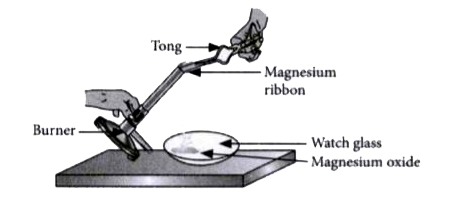A combines with B to form C and D. A and D are major contributors to global warming and both are carbon compounds. B is a supporter of combustion. Magnesium burns in the presence of B with a dazzling white flame and forms a product X which is basic in nature. With C, X forms a compound which turns red litmus paper blue. Give the respective chemical reactions involved.
To solve the problem step by step, let's break down the information provided and identify the chemical reactions involved.
Step 1: Identify the components A, B, C, and D
- A is a carbon compound that contributes to global warming. It can be identified as methane (CH₄).
- B is a supporter of combustion, which is oxygen (O₂).
- C is a product formed when A combines with B, which is carbon dioxide (CO₂).
- D is another carbon compound contributing to global warming, which is carbon dioxide (CO₂).
Step 2: Write the reaction of A and B to form C and D
The combustion of methane (A) in the presence of oxygen (B) produces carbon dioxide (C) and water (D):
CH4+2O2→CO2+2H2O
Step 3: Identify the product X formed by magnesium burning in the presence of B
When magnesium (Mg) burns in the presence of oxygen (B), it forms magnesium oxide (X):
2Mg+O2→2MgO
Here, magnesium oxide (MgO) is basic in nature.
Step 4: Identify the reaction between X and C
Now, we know that X is magnesium oxide (MgO) and C is carbon dioxide (CO₂). When magnesium oxide reacts with carbon dioxide, it forms magnesium carbonate (MgCO₃), which can be represented as:
MgO+CO2→MgCO3
Step 5: Confirm the property of the compound formed
Magnesium oxide (MgO) is basic and will turn red litmus paper blue, confirming that it is indeed a basic compound.
Summary of the Reactions
1. Combustion of Methane:
CH4+2O2→CO2+2H2O
2. Burning of Magnesium:
2Mg+O2→2MgO
3. Reaction of Magnesium Oxide with Carbon Dioxide:
MgO+CO2→MgCO3
- A is a carbon compound that contributes to global warming. It can be identified as methane (CH₄).
- B is a supporter of combustion, which is oxygen (O₂).
- C is a product formed when A combines with B, which is carbon dioxide (CO₂).
- D is another carbon compound contributing to global warming, which is carbon dioxide (CO₂).
The combustion of methane (A) in the presence of oxygen (B) produces carbon dioxide (C) and water (D):
CH4+2O2→CO2+2H2O
When magnesium (Mg) burns in the presence of oxygen (B), it forms magnesium oxide (X):
2Mg+O2→2MgO
Here, magnesium oxide (MgO) is basic in nature.
Now, we know that X is magnesium oxide (MgO) and C is carbon dioxide (CO₂). When magnesium oxide reacts with carbon dioxide, it forms magnesium carbonate (MgCO₃), which can be represented as:
MgO+CO2→MgCO3
Magnesium oxide (MgO) is basic and will turn red litmus paper blue, confirming that it is indeed a basic compound.
1. Combustion of Methane:
CH4+2O2→CO2+2H2O
2Mg+O2→2MgO
MgO+CO2→MgCO3
Similar Questions
A combines with B to form C and D. A and D are major contributors for global warming and both are carbon compounds. B is a supporter of combustion. Magnesium burns in the presence of B with a dazzling white flame and forms a product X which is basic in nature. With C, X forms a corresponding compound which turns red litmus paper to blue. Give the respective chemical reaction involved.
View SolutionA divalent metal burns in air with a dazzling white light. The ash-like residue obtained dissolves in water to form a solution which turns red litmus blue.
(i) Identify the metal.
(ii) Is the solution acidic or basic ?
(iii) Write the equations for the reactions involved .
View Solution
Knowledge Check
Observe the given figure and identify the correct statements.

(i) Magnesium ribbon burns in air with a dazzling white flame.
(ii) It is a displacement reaction.
(iii) Magnesium oxide is basic in nature and turns most red litmus paper blue.
(iv) It is an exothermic reaction.A(i) and (iii)B(ii) and (iv)C(i), (iii) and (iv)D(i) and (iv)Magnesium on burning in air forms a powder which reacts with water giving a gas which turns red litmus blue and forms white fumes with cone. HCl This gas is:
AO2BH2CNH3DCO2Magnesium on burning in air forms a powder which reacts with water giving a gas which turns red litmus blue and forms white fumes with conc. HCL. This gas is
AO2BH2CNH3DCO2
An element A reacts with water to form a compound B which is used in white washing. The compound B on heating forms an oxide C which on treatment with water gives back B. Identify A, B and C and give the reactions involved.
View SolutionAn element A reacts with water to form a compound B which is used in white washing. The compound B on heating forms an oxide C which on treatment with water gives back B. Identify A, B and C and give the reactions involved.
View SolutionAn aromatic compound (A) on treatment with ammonia followed by heating forms compound (B), which on heating with Br2 and KOH forms a compound (C) having molecular formula C6H7N. Give the structures of A, B and C and write the reactions involved.
View SolutionAn organic compound A of molecular formula C2H6O is a constituent of wine and beer.
This compound on heating with alkaline potassium permanganate forms another organic compound B which turns blue litmus to red. Identify the compounds A and B.
View SolutionAn organic compound (A) reacts with methyl magnesium iodide to form an addition product which on hydrolysis forms the compound (B). Compound (B) gives blue colour salt in Victor Meyer's test.The compounds (A) and (B) are respectively :
View Solution